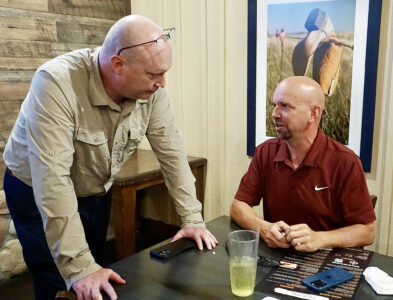Dakota Datebook: June 12-16
Flag Day
By SARAH WALKER
June 12 — Oh, say — do you remember that June 14 is Flag Day? That means that, from the dawn’s early light to the bright rocket’s — or, in this case, firecrackers’ glare — we’ll be honoring the red, white and blue banner of stars and stripes and commemorating when the United States adopted it as a symbol of our nation.
The flag has meant many things to many people. During trying times, patriotism often seems especially important. During World War II, in 1942, a sense of patriotism permeated every-day life in North Dakota. Doing what you could, giving what you could and doing without were ways of expressing support of the country and its soldiers overseas. If you were listening on June 5, you heard about food rationing that went on throughout the country in response to scarce supplies. Here in North Dakota, farmers were encouraged to “farm for freedom.” Their crops helped with grain shortages, and their livestock helped with other food shortages.
In fact, patriotism was not just for the farmers. On this day, the Devils Lake Journal reported that in response to the calls for more eggs, one unlikely individual was doing her part to fulfill her duty. A seven-year-old white giant hen, owned by the Matt Bloomquist family, was “doubling her output” by laying one double yolk, oversized egg each day. Four of the eggs weighed almost 14 ounces.
But on this day, too, everyone’s “every-day” patriotism was made a little more special, as the people of Devils Lake were already celebrating their country and Flag Day. They had a big program for the holiday, with music performed by the Boys Concert Band, some community singing, a dramatic reading of a piece titled, “Your Flag and My Flag.” This was followed by a meal, and, of course, a parade, led by a line of “massed flags” from local businesses.
And the patriotism spread across the country — as did the honoring of the flag. In fact, in Montana, a man who had so many lumps of sugar stolen from his restaurant decided to try other ways of keeping his sugar there. But when he adorned the sugar lumps with mini-American Flags, the “patriotic pilferers” changed their tactics, and afterward, he couldn’t keep his bowls of sugar “equipped with flags,” as so many people took them.
Stealing was, perhaps, not the best way of honoring our country’s starred and striped banner; however, the patriotism and celebrations did bring it honor. And the star-spangled banner did–and does –“yet wave o’er the land of the free, and the home of the brave.”
DAKOTA DATEBOOK: Fargo Grain Terminal Collapses
By Merry Helm
June 13 — During the wee hours on this date in 1955, the Fargo Grain Terminal collapsed, reducing the massive structure to a massive pile of rubble and grain.
The terminal was the largest privately owned storage facility in North Dakota at the time – second in size only to the State Mill and Elevator.
The building was 122-feet high and consisted of 20 concrete tanks with a storage capacity for 800,000 bushels of grain. At the time of the collapse, it held some 600,000 bushels of wheat and other grains weighing about 18,000 tons.
The structure, built by Ryan Construction Company of Nebraska, was less than a year old, having been completed in August 1954. The contractor told owner Joseph Eichinger to expect the elevator to sink about a foot into the ground as the building settled, saying this was typical for concrete elevators.
Eichinger said the building had listed a bit from north to south, but he and his employees compensated for the lean by shifting the grain inside. This was a common practice with grain terminals of the time.
The terminal was located at the west edge of Fargo on the south side of Highway 10. Its 205 foot-high headhouse had become a local landmark. When Eichinger left at 10 p.m. the previous night, everything seemed normal.
Several hours later, 16-year-old Joe Basquez and his girlfriend parked nearby, becoming eyewitnesses to the events that followed. Shortly after midnight, the young couple saw a blue flame emerge at the top of the structure. Then the ground shook as if from an explosion, but there was no fire. Driving through the darkness, they found the elevator had snapped at its base and had fallen to the ground.
A newspaper story reported, “When it fell northward toward the highway, a railway spur track was heaved six feet into the air. The ground on all sides was buckled.”
The cost of the collapse was estimated at about 1.5 million dollars, most of which was attributed to the stored grain. Almost everything was insured, and barring rain or fire, Eichinger hoped to salvage perhaps two-thirds of the grain from the rubble.
DAKOTA DATEBOOK: Fort McKeen
By Christina Sunwall
June 14 — Colonel Henry Boyd McKeen mustered in the service seven months after the start of the Civil War. Attached to the 81st Pennsylvania Infantry, McKeen survived wounds at the battles of Fredericksburg, Chancellorsville and Gettysburg. But leading his men in the Federal assault on Confederate positions at Cold Harbor, McKeen received a fourth and mortal wound. He died June 3, 1864.
Eight years later, on this day, June 14, 1872, a fort was established on the west bank of the Missouri, southwest of Bismarck, for the purpose of protecting engineers and work parties of the Northern Pacific railroad. In honor of the fallen Union colonel, killed in action at the Battle of Cold Harbor, the new fort was designated “Fort McKeen.”
DAKOTA DATEBOOK: Happy Chandler
By Christine Sunwall
June 15 — Former Major League Baseball commissioner, Albert “Happy” Chandler, passed away on this day in 1991. While holding the commissioner’s office, Chandler initiated the racial integration of Major League Baseball. It is a story in which North Dakota played a supporting role.
While attending college in Kentucky, Chandler spent the summer of 1920 playing with a semi-professional baseball team out of Grafton, North Dakota, where Chandler often played against African-American rivals. It was also during the summer in North Dakota that his dreams of playing in the major leagues ended. A Grafton teammate secured Chandler a tryout with the Saskatoon club in the Western Canadian League, but he failed to make the cut.
Returning to Kentucky, Chandler instead pursued a career in law and politics, eventually leading him to the baseball commissionership. Through Chandler’s efforts as commissioner, Jackie Robinson made his debut with the Dodgers in 1947.
DAKOTA DATEBOOK: Firefighters
By Sarah Walker
June 16 — Where there’s fire, firefighters are sure to follow. And lucky for us, too–for they are the protectors of a country where fiery disasters are many, varied, and terrible. Growing up, many children learn about and consider becoming firemen, and they are almost universally considered heroes, in our culture. Braving the flames, racing to avert disaster, they are men and women the rest of us can depend upon.
The Twenty Ninth Convention of the North Dakota Firemens Association was a big event for these heroes. In 1912, Williston hosted the conference, which moved around the state from year to year. The Finance Committee of the State Firemen’s Tournament had to raise $2,000 to “defray the expense of entertaining the State Firemen.” Of this, $500 was needed for prize money to secure the Tournament, and the rest was to go to a litany of things: A “barbecue, band contest prizes, bronco busting, automobile, horse and other races, tents, halls, cots and sleeping accommodations, advertising, ball games, banquet and (a) Firemen’s Ball.”
In asking for this money, the committee reminded readers that “the firemen of Williston have given years of faithful service in fighting fires. These services have been given absolutely without pay. In 18 below zero weather, they have fought fire all night in order to save and protect the property of others.” Also, they said, Williston had an opportunity in this conference to promote the city.
When the conference began, Mayor Jackson welcomed the firemen with the keys of the city, “turning the town over to them for business and pleasure.”
By this day, the glittering array of blue, green and red uniforms that had “besprinkled the streets” of Williston had returned home. However, these heroes were prominent on the minds of North Dakotans for a very good reason. This conference marked the advent of conversation about a state fire marshal. “North Dakota firemen want a state fire marshal and a campaign to have such a law passed at the next session of the legislature is one of the direct results of the … convention.”
The meeting itself is forgotten today, almost a century later; but the State Fire Marshal position lives on, a prominent result from those forgotten days long ago, and the excitement of a convention touted as the “biggest and best in the history of the association.”
“Dakota Datebook” is a radio series from Prairie Public in partnership with the State Historical Society of North Dakota and with funding from Humanities North Dakota.



